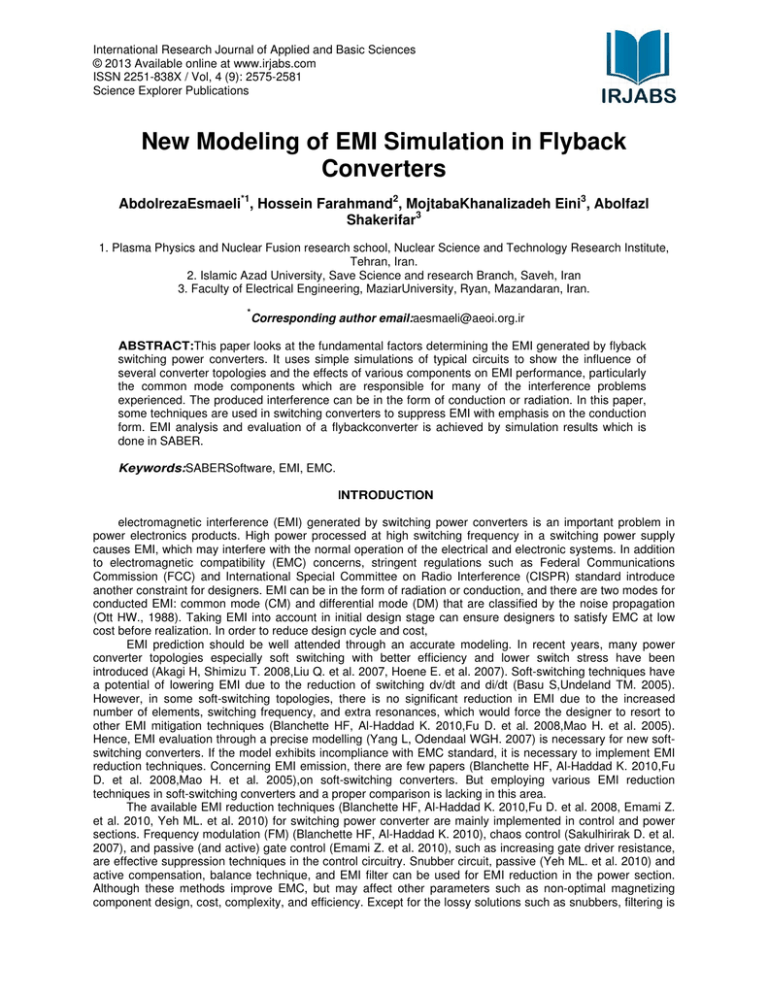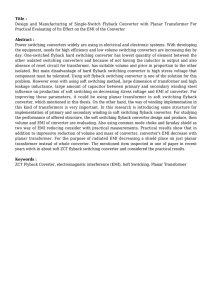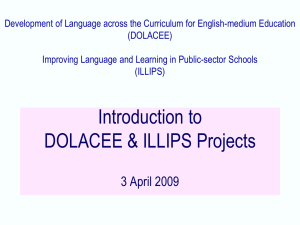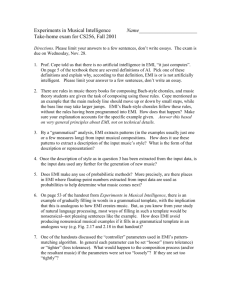New Modeling of EMI Simulation in Flyback Converters
advertisement

International Research Journal of Applied and Basic Sciences © 2013 Available online at www.irjabs.com ISSN 2251-838X / Vol, 4 (9): 2575-2581 Science Explorer Publications New Modeling of EMI Simulation in Flyback Converters AbdolrezaEsmaeli*1, Hossein Farahmand2, MojtabaKhanalizadeh Eini3, Abolfazl Shakerifar3 1. Plasma Physics and Nuclear Fusion research school, Nuclear Science and Technology Research Institute, Tehran, Iran. 2. Islamic Azad University, Save Science and research Branch, Saveh, Iran 3. Faculty of Electrical Engineering, MaziarUniversity, Ryan, Mazandaran, Iran. * Corresponding author email:aesmaeli@aeoi.org.ir ABSTRACT:This paper looks at the fundamental factors determining the EMI generated by flyback switching power converters. It uses simple simulations of typical circuits to show the influence of several converter topologies and the effects of various components on EMI performance, particularly the common mode components which are responsible for many of the interference problems experienced. The produced interference can be in the form of conduction or radiation. In this paper, some techniques are used in switching converters to suppress EMI with emphasis on the conduction form. EMI analysis and evaluation of a flybackconverter is achieved by simulation results which is done in SABER. Keywords:SABERSoftware, EMI, EMC. INTRODUCTION electromagnetic interference (EMI) generated by switching power converters is an important problem in power electronics products. High power processed at high switching frequency in a switching power supply causes EMI, which may interfere with the normal operation of the electrical and electronic systems. In addition to electromagnetic compatibility (EMC) concerns, stringent regulations such as Federal Communications Commission (FCC) and International Special Committee on Radio Interference (CISPR) standard introduce another constraint for designers. EMI can be in the form of radiation or conduction, and there are two modes for conducted EMI: common mode (CM) and differential mode (DM) that are classified by the noise propagation (Ott HW., 1988). Taking EMI into account in initial design stage can ensure designers to satisfy EMC at low cost before realization. In order to reduce design cycle and cost, EMI prediction should be well attended through an accurate modeling. In recent years, many power converter topologies especially soft switching with better efficiency and lower switch stress have been introduced (Akagi H, Shimizu T. 2008,Liu Q. et al. 2007, Hoene E. et al. 2007). Soft-switching techniques have a potential of lowering EMI due to the reduction of switching dv/dt and di/dt (Basu S,Undeland TM. 2005). However, in some soft-switching topologies, there is no significant reduction in EMI due to the increased number of elements, switching frequency, and extra resonances, which would force the designer to resort to other EMI mitigation techniques (Blanchette HF, Al-Haddad K. 2010,Fu D. et al. 2008,Mao H. et al. 2005). Hence, EMI evaluation through a precise modelling (Yang L, Odendaal WGH. 2007) is necessary for new softswitching converters. If the model exhibits incompliance with EMC standard, it is necessary to implement EMI reduction techniques. Concerning EMI emission, there are few papers (Blanchette HF, Al-Haddad K. 2010,Fu D. et al. 2008,Mao H. et al. 2005),on soft-switching converters. But employing various EMI reduction techniques in soft-switching converters and a proper comparison is lacking in this area. The available EMI reduction techniques (Blanchette HF, Al-Haddad K. 2010,Fu D. et al. 2008, Emami Z. et al. 2010, Yeh ML. et al. 2010) for switching power converter are mainly implemented in control and power sections. Frequency modulation (FM) (Blanchette HF, Al-Haddad K. 2010), chaos control (Sakulhirirak D. et al. 2007), and passive (and active) gate control (Emami Z. et al. 2010), such as increasing gate driver resistance, are effective suppression techniques in the control circuitry. Snubber circuit, passive (Yeh ML. et al. 2010) and active compensation, balance technique, and EMI filter can be used for EMI reduction in the power section. Although these methods improve EMC, but may affect other parameters such as non-optimal magnetizing component design, cost, complexity, and efficiency. Except for the lossy solutions such as snubbers, filtering is Intl. Res. J. Appl. Basic. Sci. Vol., 4 (9), 2575-2581, 2013 a regular solution to meet EMC standard in power converters. But the filters often have to be designed and tuned after the implementation stage (Akagi H, Shimizu T., 2008), which would increase the design time in addition to the size and cost of the power electronic products. Since filtering is unavoidable in order to achieve further EMI reduction and comply with strict EMC regulations, it is desirable to employ simple and effective EMI suppression methods to reduce filtering characterization before designing and implementing the filter. Efficiency and switch stresses are usually the main goals in the selection or design of power converter topologies (Hoene E. et al. 2007, Liu Q. et al. 2007). EMC improvement methods in the power section usually do not change the topology and are implemented on the sideline. In this paper, a better EMC behavior along with other desirable converter parameters is considered in the topology design of power section. Due to a better EMC performance, the proposed converter can meet CISPR22 standard by simple reduction methods without any complex or expensive reduction solution. Since flyback converter is widely used as an isolated power Supply. This paper is organized as following. However, a flyback converter generally suffers from low efficiency and poor cross regulation because of the leakage inductance. In reality, no matter how to range the winding structure inside the transformer, the leakage inductance cannot be completely eliminated. Among the currentlyexisting transformer-coupled switching-mode DC-to-DC converters, the flyback converter is the simplest topology, since no choke is required, only one power switch is used and the high-frequency power transformer with unfiled windings is employed. In addition to these structural advantages, it also possesses the merits of easy to obtain wide-range output voltage and multiple output voltage with good transient response. As a result, it has been extensively designed for many applications, and some physical dynamic modelling and controller design techniques have been revised for improving its dynamic behaviour. The simulations and their analysis are done by SABER software, one of the best electrical software in the world. FLY-BACKSWITCHING CONVERTER Figure 1.Fly-Back Topology The circuit diagram of a Fly-back switching power converter as shown in Figure 1. The primarywinding of Tr acts as an inductor when the transistor is in ON state.In the OFF state of T1, the transformer assures the isolation between the load and the input power supply. It also provides an output voltage as load circuit request as long as there is energy stored in the magnetic core. The turns ratio is n = n1 / n2.The main theoretical wave forms that describe the operation modes of the switched mode Fly-back converter are shown in Figure 2. If the converter operates in steady state continuous conduction mode CCM (which means the energy that exist the operation in transformer is greater or at least equal with zero during the supply) and if input Ui and output Uo voltages are considered for simplicity both constant, using the volt-second balance or the primary winding, one can derive the next relation: D (1) Ui 1− D In (1) D is the duty cycle of the pulse width modulated command voltage Ucd which has a constant time period T. when the transistor T1 is turned ON, the current i1 can be described by (2): Uo = N −1 i 1 max − i 1 min = Ui DT L1 (2) 2576 Intl. Res. J. Appl. Basic. Sci. Vol., 4 ((9), 2575-2581, 2 , 2013 The average current through diode D reflected in the primary winding of the transformer Tr is obtained with the next relation: i1 max + i1 min Uo = n −1 2 ( 1 − D )R (3) From (2) and (3) one can derive the minimum value of the primary winding inductance at the boundary condition between continuous conduction mode CCM and discontinuous conduction mode DCM DCM,, when i1min=0, with the following relation L 1 min = 1 2 n ( 1 − D ) 2 RT 2 (4) The relation (4) is useful in the design of the switched mode Fly-back Fly back converter. MODEL OF FLY-BACK FLY CONVERTER The first step in modelling of the Fly-back Fly back converter is to use an equivalent circuit for the transformer Tr This device was replaced by two inductors and an ideal electrical transformer. The two inductors represent the leakage inductance LS and magnetizing magnetizing inductance LM of the real transformer. For the ideal transformer, the turns of the primary and the secondary windings are n1 and n2 respectively. Taking into account the model of the real transformer, one can obtain a new equivalent topology of the switc switched hed mode converter, as is shown in Figure 3. 3 Figure Fig 2.Wave ave forms fforDCMand nd CCM Figure 3.Equivalent 3 Equivalent topology of Fly Fly-back back converter. In each operation cycle, there are three operation modes that are reliant with the state of the electronic power devices and the evolution in time of the state variables. For the operation period of each mode a first 2577 Intl. Res. J. Appl. Basic. Sci. Vol., 4 (9), 2575-2581, 2013 order differential equations system can be written with a set of initial conditions. The initial conditions used to solve the differential equations systems are the values of the state variables, obtained at the end of the previous operation mode (Hoene E., 2007). In the first operation mode, transistor T1 is turned on with the help of Ucdand diode D is turned off due to the polarity of the voltage on the secondary winding. The corresponding circuit of this operation mode is shown in Figure 4. Figure 4.Equivalent circuit of operation mode. The current does not pass through dashed circuits, which mean that their value is zero. The next system describes the operation principle for this mode of operation and it includes the parasitic elements LS and LM of the transformer as well as the voltage drop UCEon of T1 in its ON state. In this system, the state variables are the current i1 through the leakage inductance, magnetizing current iM and capacitor voltage uC. 0 0 0 i1 U i − u CEon Ls L M 0 d (5) 1 iM + 0 0 C dt 0 0 − 0 R uC The currents through the two parasitic inductances are equal while the currents through the windings of the ideal transformer i1 and i2 are zero. The capacitor C assures the energy for the load. In the second operation mode, the command voltage ucd brings the transistor T1 in off state and diode D is turned on due to the energy from the magnetizing inductance LM. Figure 5 shows the equivalent circuit of the Fly-back converter. The currents flow only in the circuits marked with solid line. During the period of this operation mode two things could happen. If the magnetizing current iM becomes zero before to start a new operation cycle, the Flyback converter operates in DCM. If the value of the magnetizing current iM is greater than zero the Fly-back converter runs in CCM. The third operation mode begin when the value of the magnetizing current iM become zero. It is obvious that this operation mode appear only when theFlyback converter operates in DCM. This operation mode is absent in CCM. For DCM, the third operation mode can be followed with the help of the equivalent topology shown in the Figure 6. For this operation mode one can write the next system. 0 0 0 0 i 0 0 d 1 i = C dt M 0 uC 0 i1 1 iM 0 − R uC 0 (6) Figure 5.Equivalent circuit of the Fly-back converter 2578 Intl. Res. J. Appl. Basic. Sci. Vol., 4 (9), 2575-2581, 2013 Using (5) and (6), it was implemented in SABER a program that is used to simulate the operation of the Fly-back converter in time domain. This program is able to simulate the CCM and DCM as well as transient period and steady state operation of the Fly-back converter. The principles used to implement the simulation program in the SABER. Figure 6. Equivalent topology of Flyback Converter EMI MODELING OF A FLYBACK CONVERTER Since PWM flyback converters are widely used as isolated power supplies especially PFC applications, the hard switching flyback topology is selected for EMI modelling in this paper. A 70W flyback converter with 150V dc input voltage; 50V output voltage operating at 100 kHz switching frequency is designed. The main switch is existing IGBT at SABER. Conventional flyback converter EN55011 standard has EMI limits at 9–150 kHz frequencies. Due to the switching frequency of the converter, the amplitude of the main harmonic located in the mentioned frequency range, will be critical. To predict EMI, it is necessary to characterize the main, parasitic elements in the circuit. Therefore, exact models of components such as inductor, capacitor, resistor and switch should be considered in the simulation. Drain and source terminal inductances are added to the switch model according to the manufacturer datasheet. Also, ESL and ESR of capacitors are considered based on the datasheet. The elements of the transformer model consist of: Primary inductance of 0.95 mH and resistance of 0.3 , secondary inductance of 130 H and resistance of 0.05 , leakage inductance of 4.2 H and total inter-winding capacitance of 49 pF. In this case, the selfcapacitances of windings have less impact on the conducted EMI with respect to intertwining capacitances (Emami Z. et al. 2010) and are ignored to simplify the transformer model. The drain-earth capacitor (CDE) as an important EMI Common mode path (Yeh ML. et al. 2010) is also obtained by measurement. This paper focuses on component models for the EMI modeling. Nevertheless, for PCB traces, only typical values of inductances are considered. Critical traces are those involved in high di/dt and dv/dt loops. Also, the trace distances are assumed large enough, so that the capacitive couplings are minimized and therefore they can be ignored. Also self-capacitances of traces are considered negligible. In (Yeh ML. et al. 2010), self -partial inductance as a function of the trace width is presented. For instance, the inductance of at race with 25.4 mm length, 2.54 mm width and 2 mm height from the bottom plane is around 10nH. In this paper, the inductances of the critical traces are assumed about 40nH due to the layout and typical range of the trace inductance. Although this estimated assumption reduces the EMI prediction accuracy, but the simulation complexity and time would be reduced. Finally, detailed circuit model is derived for the IGBT as shown in Figure7. EMI model of the hard switching flyback converter to evaluate conducted EMI in both CM and DM; LISN’s are utilized according to CISPR22 standard. The unit of the conducted EMI level is dB V(defined in (7)) in the range 150 kHz to 30 MHz which has been perceived in Figure 8. In this frequency range, the main harmonic is located at 100 kHz. Figure 9 shows the simulation results of the conducted EMI on R1 (50 LISN terminal) obtained from SABER. dBµV = 20.log (v/µV) (7) SIMULATION OF FLY-BACK CONVERTER To evaluate the EMI model established in last section, EMI emissions of the flyback prototype converter are measured. A 70W flyback prototype is implemented at 110Vrms (Rectified) input voltage and 100 kHz switching Frequency. Figure 9 shows the Conducted EMI spectrum of hard switching 2579 Intl. Res. J. Appl. Basic. Sci. Vol., 4 ((9), 2575-2581, 2 , 2013 flybacksimulation results to convert the conducted EMI limits in EMC standards which are defined as dB V. flybacksimulation To measure conducted EMI, according to CISPR22 LISNs are realized by the means of air core inductors and MKT capacitors. An Air core inductor is realized wit with h only one layer winding on a PVC pipe with 1mm thickness to make 50 H inductance for better performance. Figure 7.EMI EMI model of the hard switching flyback converter Figure ure 8.CISPR22 CISPR22 LISN scheme for conducted EMI simulation and Measurement. Trigger model of IGBT IGBT. Figure 9. Conducted EMI spectrum of hard switching flyback –simulation simulation Results with SABER. LISNs are connected between 110Vac 110Vac input lines and the input of the prototype. To attenuate the radiated EMI from the prototype elements such as the transformer, an Aluminum case is used for the converter which is connected to earth to act as a shield. The resolution band width (RBW) of the spectrum analyzer is set at 300Hz. Mismatching between prediction and measurement are due to the estimating trace 2580 Intl. Res. J. Appl. Basic. Sci. Vol., 4 (9), 2575-2581, 2013 inductance and ignoring exact trace parasitics. Also parasitics of the LISN wires and cables are not included in the simulation.These parasitics are neglected in the simulation to avoid more complexity and have a fast estimation of EMI. Furthermore, the step time changes during the SABER simulation and also the RBW is not set in the simulation. These two points are drawbacks for an exact FFT analysis considering fast EMI prediction.Figure 10 shows the Conducted EMI spectrum of hard switching flyback. Figure10. Conducted EMI of switching flyback converter–new modeling and filter, simulated with SABER. CONCLUSION The EMI modeling helps designers to predict EMI levels in the design stage and before system realization. Modeling highfrequency components including parasitic should be send to simulate the conducted EMI in SABER. In addition to the component parameters, measurement and manufacturer datasheet are considered to extract the detailed model. EMI measurement using LISNs shows that the derived model approximately predicts the EMI levels specially the peak amplitude at the fundamental frequency. Also, the effect of the spread spectrum technique on the EMI spectrum is examined. The experimental result shows that this technique can significantly reduce EMI, especially the aim harmonic in the hard switching flyback simulated in SABER. REFERENCES Akagi H, Shimizu T. 2008.“Attenuation of conducted EMI emissions from an inverter-driven motor,” IEEE Trans. Power Electron., vol. 23, no.1, pp. 282-290, Jan. Basu S, Undeland TM. 2005. “Diode recovery characteristics Considerations for optimizing EMI performance of continuous mode PFC converters,” in Proc. IEEE EPE'05, pp. 1-9, Blanchette HF, Al-Haddad K. 2010. “Solving EMI-related problems for Reliable high-power converters design with precomputed electromagnetic models,” IEEE Trans. Power Electron., vol. 25, no. 1, pp. 219-227, Jan. Emami Z, Farzanefard H, Motahari SR. 2010. “EMI evaluation in hard Switching and soft switching PWM flyback converters,” in Proc. IEEE EDSTC’10, pp. 46-51, Feb. Fu D, Kong P, Wang S, Lee FC, Xu M. 2008.Analysis and Suppression of conducted EMI emissions for front-end LLC resonant DC/DC converters,” in Proc. IEEE PESC'08, pp. 1144-1150, Hoene E, Lissner A, Guttowski S. 2007. “Prediction of EMI behavior in terms of passive component placement,” in Proc. IEEE 18th Symp.EMC, pp. 49-52, Sep. Liu Q, Wang F, Boroyevich D. 2007. “Conducted-EMI prediction for AC converter systems using an equivalent modular-terminal-behavioral (MTB) source model,” IEEE Trans. Ind. Appl., vol. 43, no. 5, pp. 1360–1370, Sep./Oct. Mao H, Deng S, Abu-Qahouq J, Batarseh I. 2005. “Active-clamp Snubbers for isolated half-bridge DC–DC converters,” IEEE Trans. Power Electron.vol.20, no. 6, pp. 1294-1302, Nov. Ott HW. 1988.Noise reduction techniques in electronic system, Second diction, John Wiley & Sons, Sakulhirirak D, Tarateeraseth V, Khan-ngern W, Yoothanom N. 2007. “Design of high performance and low cost line impedance stabilization network for university power electronics and EMC laboratories,” in Proc. IEEE PEDS'07, pp. 284-289, Yang L, Odendaal WGH. 2007. “Measurement based method to Characterize parasitic parameters of the integrated power electronics Modules,” IEEE Trans. Power Electron. vol. 22, no. 1, pp. 54-62, Jan. Yeh ML, Liou WR, Hsieh HP, Lin YJ. 2010. “An Electromagnetic interferenc (EMI) reducedhigh-efficiency Switching power amplifier,” IEEE Trans. Power Electron., vol.25, no. 3, pp.710-718, March 624 2581






